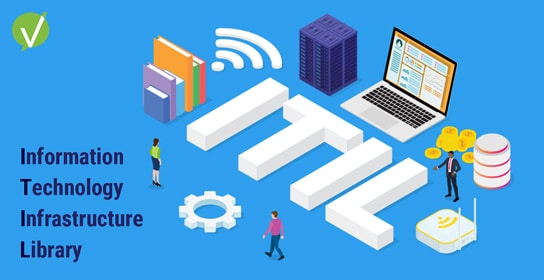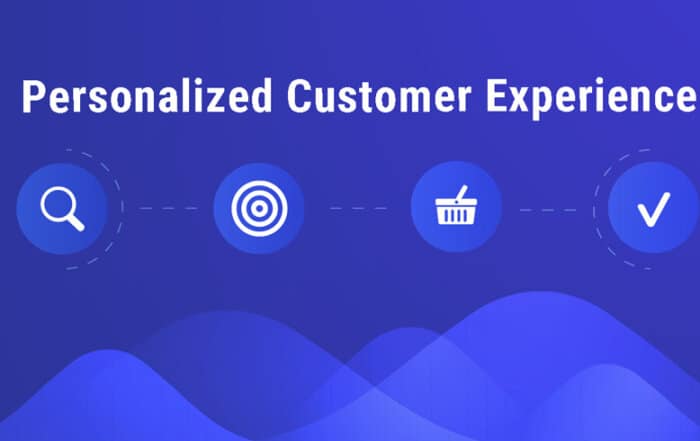Why ITIL is Important: Understanding its Significance
Introduction
Staying ahead of the competition requires a strategic approach to IT service management. This post will help to answer the following questions:
- Why is ITIL your company’s secret sauce?
- How does ITI help allocate resources effectively?
- How does ITIL help enhance service delivery?
- How can you reduce risk and disruption with ITIL?
- How can your business gain greater visibility of your costs, assets, and value?
- How to align IT with your business through ITIL Training?
- How to unlock the potential of ITIL?
Why is ITIL your company’s secret sauce?
In today’s fast-paced business world, efficiency isn’t just a goal; it’s a game-changer. This is why ITIL (the Information Technology Infrastructure Library) is important. It’s not merely a framework; it’s the secret sauce that can transform your organization from struggling with IT chaos to running like a well-tuned engine. But how?
We are glad you asked…
Imagine a police department dealing with multiple IT systems, from computer-aided dispatch to records management, and various communication channels:
- Data Silos: Critical information about ongoing investigations, incidents, or suspects may be trapped in separate, unconnected systems, making it difficult for law enforcement personnel to access essential data when needed.
- Compliance Risks: Government agencies are subject to strict data security and compliance regulations. Inadequate ITSM practices could result in compliance breaches, leading to legal and financial repercussions.
- Cost Overruns: Without proper ITSM, it’s challenging to manage IT assets effectively. This can lead to unnecessary expenses through over-purchasing or inefficient use of your people’s resources.
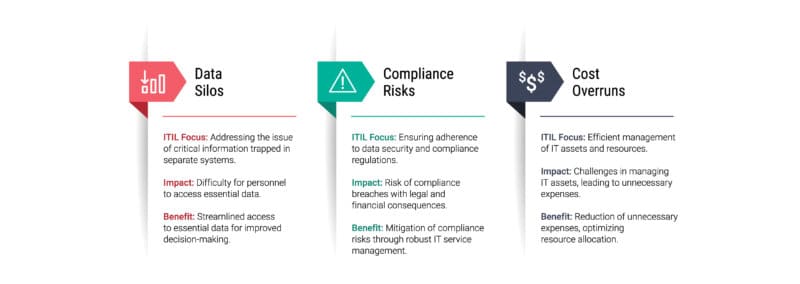
How does ITIL help allocate resources effectively?
Now, imagine being tasked with the challenge of bringing all these disparate IT systems and communication channels together seamlessly. Where would you even begin, and how could you ensure they work in perfect harmony? This is where ITIL can help you work smarter, not harder.
Let’s see how ITIL-based ITSM can transform this police department’s IT system’s management:
- Efficient Incident Management: ITIL emphasizes streamlined incident management. In a police department, this means faster resolution of IT issues. When an officer faces a technical problem, the ITSM system ensures that it’s resolved promptly, allowing them to focus on their core duties.
- Unified Data Access: ITIL principles advocate for the integration of systems and data. In this context, it means that all relevant information, such as criminal records, ongoing cases, and dispatch details, can be accessed seamlessly, providing officers with real-time data critical for decision-making and public safety.
- Data Security: ITIL-driven ITSM places a strong emphasis on data security and compliance. This ensures that sensitive information is safeguarded, minimizing the risk of data breaches and ensuring the department’s compliance with legal regulations.
- Cost Optimization: Effective ITSM also includes asset management, allowing the police department to track and manage its IT resources efficiently. This can help reduce unnecessary expenses, ultimately saving taxpayers’ money.
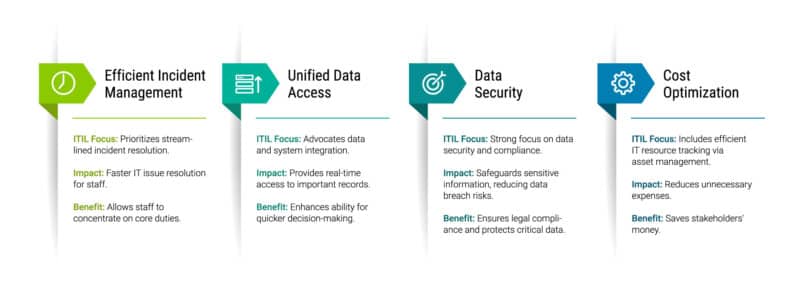
Now you may see how ITIL-based ITSM can be a game-changer for a police department by improving service efficiency, data accessibility, security, compliance, and cost management. It enables law enforcement agencies to better serve their communities, enhance public safety, and allocate resources effectively.
But this is just one industry and one example. So the real question is, “Why is ITIL important to your business?”
ITIL Enhances Service Delivery
So what is service delivery exactly? Simply put it’s the process your company uses to provide ongoing service to your customers or clients in a way that meets or exceeds their expectations and in today’s market, service delivery is a commodity. If your company is able to excel in the activities, processes, and interactions that occur from the initial request for a service to its fulfillment and beyond, you and the customer both win.
For you, you gain client retention and industry referrals, while the customer gains service delivery that specifically focuses on the efficient and effective provision of IT services to their organization’s internal or external needs.
This includes activities such as incident management, problem resolution, change management, and service level management, all aimed at ensuring that IT services are delivered in a way that aligns with their organization’s business goals and objectives while meeting agreed-upon service levels and quality standards.
Reducing Risk and Disruption with ITIL
IT disruptions can be costly and damaging to your business. ITIL helps mitigate these risks by providing guidelines for incident and problem management. By following, organizations can handle IT issues swiftly and effectively, minimizing their impact on operations and customers. This reduction in risk not only saves money but also ensures uninterrupted business operations, thereby increasing productivity.
Imagine Dunkin’ Donuts, a multinational coffee chain with thousands of franchised retail stores relying heavily on various IT systems to manage their operations, from point-of-sale (POS) systems to inventory management and employee scheduling software. Any disruption in these IT systems could lead to a significant loss in revenue and customer dissatisfaction.
Now, let’s say Dunkin’ Donuts adopts ITIL principles for incident and problem management. When an IT issue arises, such as a POS system malfunction that prevents customers from making transactions, their IT team follows ITIL best practices. They quickly identify and address the problem, ensuring minimal downtime.
By efficiently managing IT incidents and problems, Dunkin’ Donuts can:
- Minimize Revenue Loss: With ITIL, they can reduce the time it takes to resolve IT issues, which means fewer missed sales opportunities during downtime.
- Enhance Customer Satisfaction: Customers can continue to enjoy their coffee without disruptions, leading to higher customer satisfaction and loyalty.
- Ensure Productivity: Employees can work without IT interruptions, leading to increased productivity in stores.
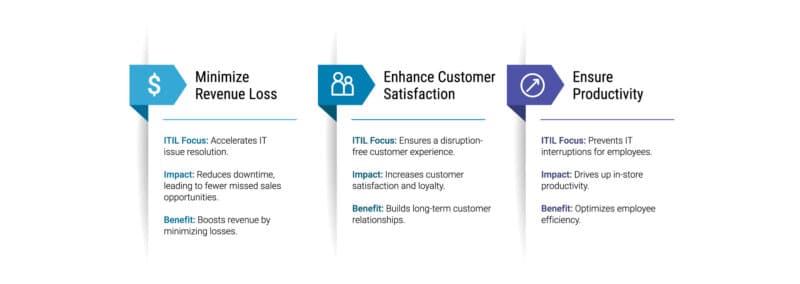
In this way, ITIL helps Dunkin’ Donuts mitigate the risks associated with IT disruptions, saving them money, maintaining smooth operations, and ultimately ensuring a positive customer experience.
Greater Visibility of Costs, Assets, and Value
Transparent cost management is crucial for your business. ITIL emphasizes the importance of managing costs effectively. It provides insights into the costs associated with IT services, assets, and processes. With this greater visibility, your organization can identify areas of over-investment and optimize resource allocation, resulting in improved cost-effectiveness.
Now let’s explore a highly regulated industry that manufactures and supplies cutting-edge medical equipment and analytical instruments to hospitals and research institutions. Cost management is critical for their business success, as they need to balance quality and innovation with cost-effectiveness.
By adopting ITIL principles, organizations in the medical tech market gain greater visibility into their IT costs, which include expenses related to maintaining and upgrading their analytical instruments, managing their IT infrastructure, and providing customer support for their medical equipment.
Here’s how ITIL can serves the medical technical market:
- Identifying Over-Investment: With ITIL, you can pinpoint areas where you may be overspending, such as redundant software licenses or over-maintenance of certain equipment.
- Optimizing Resource Allocation: By understanding your IT costs better, you can allocate resources more efficiently. For instance, you may reallocate funds from low-impact IT processes to research and development efforts that drive innovation.
- Enhancing Cost-Effectiveness: This optimized resource allocation ultimately leads to improved cost-effectiveness. You can deliver high-quality medical equipment and analytical instruments to your customers while maintaining competitive pricing.
In this example, ITIL empowers solutions to manage costs effectively, make informed decisions about resource allocation, and deliver innovative solutions to your customers while maintaining a healthy bottom line.
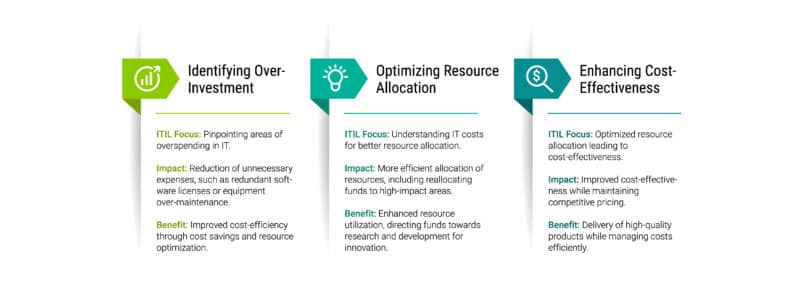
Fostering Business Agility Through ITIL
In today’s dynamic business landscape, agility is a prized trait. ITIL supports business agility by aligning IT services with your broader business goals. This alignment enables you to respond quickly to changing market conditions and customer demands. Whether you need to scale your services up or down, ITIL’s principles can guide you in adapting efficiently.
Align IT with Business through ITIL Training
As technology advances at an unprecedented pace, businesses must continuously adapt and innovate to remain competitive. This is where ITIL (the Information Technology Infrastructure Library) training comes into play, offering a powerful means to align your IT operations with your overall business strategy.
Imagine a scenario: your organization’s IT department functions as a separate entity, detached from the core business objectives. IT operations are carried out in isolation, with little consideration for how they impact the broader goals of the company. This misalignment often leads to inefficiencies, missed opportunities, and a failure to leverage technology as a strategic asset.
Now, consider the alternative: ITIL training that empowers your IT team to understand, embrace, and align their efforts with your mission and objectives. This training provides your team with the tools, methodologies, and best practices needed to bridge the gap between IT operations and business strategy. Here’s how it works:
- Common Language and Understanding: ITIL training introduces a common language and understanding of IT service management across your organization. It ensures that IT professionals and business leaders speak the same language, facilitating effective communication and collaboration.
- Business-Centric Approach: ITIL emphasizes the importance of viewing IT services through a business-centric lens. It encourages IT professionals to align their decisions and actions with the needs and goals of your business, ultimately driving value and growth.
- Enhanced Service Quality: Through ITIL training, your IT team gains the knowledge and skills to deliver high-quality services that directly contribute to the success of your business. This includes improved incident management, faster problem resolution, and a focus on meeting service level agreements (SLAs).
- Cost Efficiency: By aligning IT operations with business objectives, ITIL training helps identify opportunities for cost savings and resource optimization. It enables your organization to allocate resources more efficiently, ensuring that IT investments align with strategic priorities.
- Flexibility and Adaptability: As we stated, adaptability is key. ITIL training equips your IT professionals with the flexibility to respond to changing market conditions, customer demands, and emerging technologies, ensuring your organization remains agile and competitive.
- Improved Decision-Making: With a deep understanding of ITIL principles, your IT team can make informed, data-driven decisions that align with the business strategy. This leads to better planning, resource allocation, and risk management.
- Customer-Centric Focus: ITIL training instills a customer-centric mindset within your IT department. It emphasizes the importance of understanding and meeting the needs of internal and external customers, resulting in improved customer satisfaction and loyalty.
- Strategic Growth: Ultimately, ITIL training positions your organization for strategic growth. It equips you to harness the full potential of technology as a driver of innovation, efficiency, and competitive advantage.
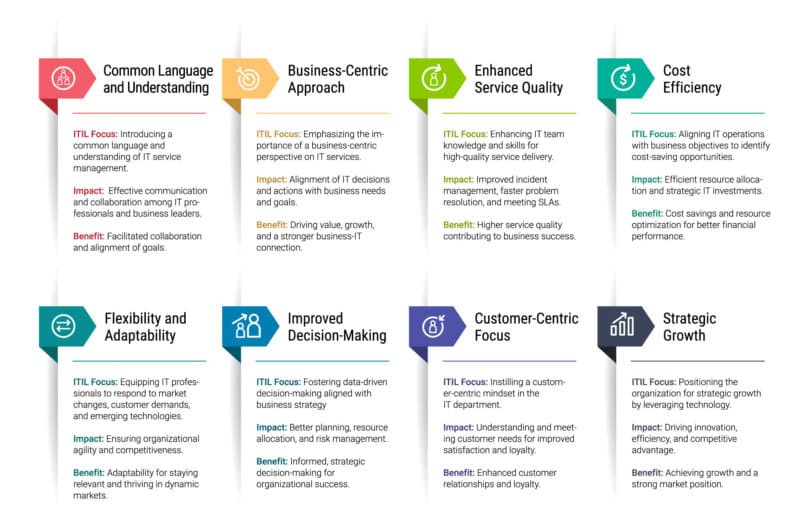
In essence, ITIL training isn’t just about teaching IT professionals how to manage services; it’s about transforming IT into a strategic asset that propels your business forward. By aligning IT with business objectives, you can achieve greater efficiency, cost savings, and overall success.
Unlock the Potential of ITIL
For over two decades, Vivantio has been equipping organizations like yours with the tools and expertise to harness the full potential of ITIL. We stand ready to be your trusted partner on your journey towards maximizing the benefits of ITIL for enhanced service quality, streamlined operations, and a more efficient, responsive organization.
Don’t miss the opportunity to unlock the full potential of ITIL. It’s not merely a framework; it’s your strategic advantage for addressing critical pain points, enhancing efficiency, boosting revenue, and ensuring business success. Take the first step towards elevating your service quality, minimizing downtimes, optimizing incident management, and aligning IT services with your organizational goals. Harness the power of ITIL to drive efficiency, profitability, and success. Contact our team at Vivantio today or register for a free demo to begin your journey towards IT service management excellence.
